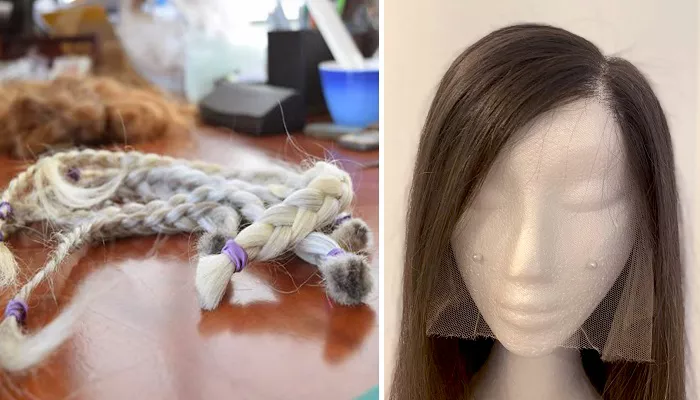For master wigmaker Rachel Walker, crafting a single custom wig can take up to 450 hours—a meticulous process of hand-tying human hair, strand by strand, onto a delicate Swiss lace base. But for the Tasmania-based artisan, it’s more than just a job. It’s a labor of love.
After 36 years as a hairdresser, Walker became frustrated by the lack of natural-looking, identity-affirming wigs available to clients facing medical hair loss. Ten years ago, she shifted her career—and life—by learning the ancient art of wigmaking in New York. Today, she is one of only a handful of professional human-hair wigmakers in Australia.
“I thought, after years of frustration, I can do better than this,” she said.
The Craft Behind Each Wig: Patience, Precision, Passion
Creating a wig isn’t just about sewing strands into a cap. The process begins with sourcing or matching donated hair by color, texture, and density. For some clients, maintaining their former look is a vital emotional touchpoint. That’s why Walker spends hours choosing just the right silver or white strands—among the most difficult to source due to shorter cuts or hair coloring trends.
Once the match is made, the true work begins. Walker sits in her home studio, peering through a magnifying glass, ventilating hair onto lace in 5–6 hour stretches when she’s in “the zone.” Even the smallest pieces, like a topper designed to blend with a client’s remaining hair, can take nearly 100 hours to complete.
And while she laughs about finding hair everywhere—her food, laundry, and even her own hair—she wouldn’t trade it.
“It’s a way of bringing joy into people’s lives when they’ve lost what they’ve lost.”
Donated Hair With Decades of Meaning
Walker’s work is supported by generous donations of hair from across Australia and New Zealand. Some donations arrive decades after the cut—a recent one included a brown ponytail saved by a parent for 37 years, still tied with its original 1980s bobble.
“To give [that hair] out of the generosity of their own heart … it’s just beautiful,” Walker said.
While she primarily uses donated hair to reduce costs for clients, the sheer hours involved in each wig still mean prices in the thousands. For those unable to afford it, Walker encourages donations to charities and nonprofits that provide free or low-cost wigs to people undergoing treatment.
More Than a Wig—A Return to Self
For Barb Jeffery of Western Australia, a topper made by Walker was life-changing. After living with scarring alopecia for years, she named her piece “Moira,” after a wig-loving character from Schitt’s Creek.
“When I’m out with my normal hair, people would look at the top of my head—that used to upset me,” said Jeffery.
“Now I take a photo any time I have Moira. It makes you feel good again.”
When she tried the topper for the first time, the emotional impact was instant.
“I think I burst into tears, Rachel did as well … I looked in the mirror and thought, ‘Wow, where have you been?’”
The Ethical Dilemma of Sourcing Human Hair
While Walker avoids using temple hair or untraceable suppliers, she admits ethical sourcing is a growing challenge—especially with disruptions from the war in Ukraine, where her main supplier was located.
Anthropologist Assa Doron, who’s studied the global hair trade for over a decade, confirms the industry is largely unregulated. His research revealed exploitation in parts of India, where hair is collected by waste pickers or cut from pilgrims in temples and sold without consent.
“There’s no standard certification system for ethically sourced hair,” Doron said, calling for better industry regulation.
Walker takes a firm stance: “I refuse to buy temple hair and try to source as ethically as possible.”
Hope and Help Beyond High-End Wigs
For those unable to afford handmade wigs, organizations like the Cancer Council offer synthetic wigs and turbans free of charge. The Australia Alopecia Areata Foundation also provides wig resources, while groups like Sustainable Salons collect and sort ponytails for donation to charities and wigmakers.
Claire Prior, Supportive Care Director at the Cancer Council Tasmania, sees firsthand the emotional transformation wigs can offer.
“I often get to see people walking out with their shoulders up,” she said.
The Lasting Power of Hair, and Hope
Whether it’s a 450-hour full wig or a 98-hour topper, Walker’s creations are more than just hairpieces—they’re emotional lifelines.
“You don’t have to donate to me,” she emphasizes. “Donate to any wig-making charity. It’s about helping someone feel like themselves again.”
In a world where hair can carry decades of meaning, Rachel Walker’s work serves as both artistry and advocacy—one strand at a time.
Related Topics:
- Naples Salon Elevates Hair Health with Specialized Scalp Treatments
- How a $20 Dandruff Shampoo Transformed My Scalp and Hair Health
- 5 Proven Herbal Remedies That Naturally Support Hair Growth


